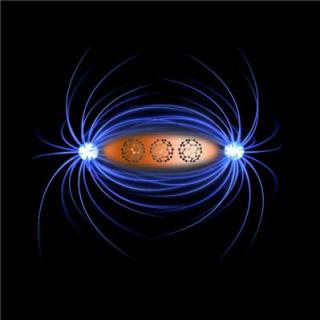University of Leeds researchers have led a study that demonstrates the possibility of generating magnetism in naturally non-magnetic metals. Currently, rare and toxic elements are used to produce magnetic materials. This study could help end the dependence on such elements.
 Copper buckyballs
Copper buckyballs
The Stoner Criterion is a condition that must be fulfilled for an element to be considered magnetic. In this study, the team proposed a method for altering matter’s quantum interactions so as to "fiddle the numbers" in this mathematical equation.
Co-lead author Fatma Al Ma’Mari, from the School of Physics & Astronomy at the University of Leeds, said: “Being able to generate magnetism in materials that are not naturally magnetic opens new paths to devices that use abundant and hazardless elements, such as carbon and copper.”
Magnets are used in a wide range of technological and industrial applications. In computer hard disks they are used for storing memory, and in wind turbines they are used for generation of power. Magnets are also used in medical imaging and various other applications.
“Future technologies, such as quantum computers, will require a new breed of magnets with additional properties to increase storage and processing capabilities. Our research is a step towards creating such ‘magnetic metamaterials’ that can fulfill this need,” said Al Ma’Mari.
Currently, only three elements – iron, nickel and cobalt, are known to be ferromagnetic at room temperature conditions. Ferromagnetic elements are those that can become magnetic, and also remain magnetic, even when a magnetic field is not present. Paramagnetic substances are those that are not magnetic by themselves, and get attracted to a magnet’s poles in a weak manner.
Co-lead author Tim Moorsom, also from the University’s School of Physics & Astronomy, said:
Having such a small variety of magnetic materials limits our ability to tailor magnetic systems to the needs of applications without using very rare or toxic materials. Having to build devices with only the three magnetic metals naturally available to us is rather like trying to build a skyscraper using only wrought iron. Why not add a little carbon and make steel?
Though iron and manganese are located adjacent to each other in the periodic table, manganese is not ferromagnetic, while iron is. This is determined by the Stoner Criterion. Professor Edmund Clifton Stoner was a theoretical physicist at the University of Leeds and he worked there from the 1930s until the 60s. He formulated the Stoner Criterion that analyzes electron distribution in an atom and the interaction strength between the electrons.
For an element to be considered ferromagnetic, the Stoner Criterion states that the product of the ‘exchange interaction’ and the Density of States (DOS) should be greater than one. The DOS is the number of various states that electrons are allowed to occupy in the orbitals that are around an atom’s nucleus.
The magnetic interaction that takes place between electrons within an atom is known as ‘exchange interaction’. Each electron’s magnetic ‘spin’ has an orientation, and this determines the magnetic interaction. Elementary particles carry intrinsic angular momentum with ‘up’ or ‘down’ options, and this intrinsic angular momentum is described by the electron’s magnetic ‘spin’ orientation.
The research team has demonstrated a way to change the DOS and the exchange interaction in non-magnetic materials by using a ‘buckyball.’ A thin carbon molecule C60 layer was used to coat the interface, and this was used to remove some electrons in the non-magnetic materials.
The non-magnetic material is able to overcome the Stoner Criterion due to the electron movement between the molecules and the metal.
Dr Oscar Cespedes, principal investigator of the project, also from the University’s School of Physics & Astronomy, said: “We and other researchers had noticed that creating a molecular interface changed how magnets behave. For us, the next step was to test if molecules could also be used to bring magnetic ordering into non-magnetic metals.”
The team states that they have successfully demonstrated the novel technique in this study. However, they believe that further research must be done to increase the strength of the synthetic magnets.
“Currently, you wouldn’t be able to stick one of these magnets to your fridge. But we are confident that applying the technique to the right combination of elements will yield a new form of designer magnets for current and future technologies,” said Dr Cespedes.
This study paper has been published in the journal Nature.